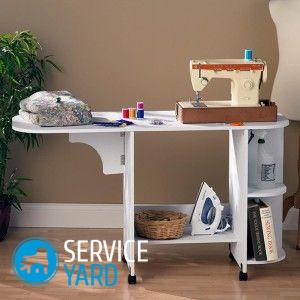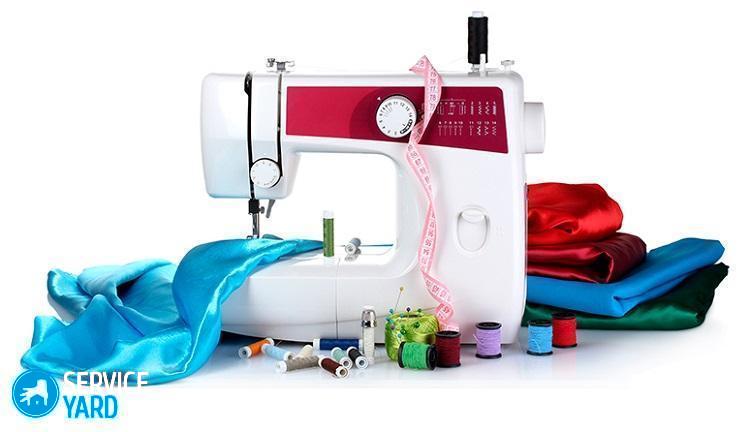How to repair a sewing machine yourself?

Sewing original and much-needed things on your own is great, especially if you know how to use a sewing machine. Everyone who had a good old “Seagull” at home wondered how to repair a sewing machine on their own? Oddly enough, this is quite simple, especially if you know the cause of the problem. And in order to find out the reason for their appearance, read this article, which contains all the material on this topic.
to contents ↑Sewing Machine Needles
It’s nothing strange that the needle is the most important part of the sewing machine. It may turn out that it is not necessary to repair the sewing machine at all, but only to establish the correct process of setting up and operating the system.
Natural wear
During her life, she makes hundreds of thousands of punctures of tissue, and no one says that it is always light and thin tissue. Therefore, it is logical that the tip of the needle becomes dull, and the needle itself may bend.

Important! Do you pay attention to this? At first glance, the needle is whole, which means that everything is normal with it. But use a magnifying glass and examine its tip - the blade will be bent in any direction, and how will such a tip accurately pierce the fabric? No way, just break through it.
Now let's see how such a needle forms a stitch. The thread that is in the eye of the needle clings to a curved point, slows down, thereby forming an excess of the upper thread inside the stitch. This is one of the reasons that loops appear on the line.
Important! In addition, a curved point will cause a periodic breakage of the thread, especially in areas difficult to sew, when the upper thread is extremely stretched.
Based on this, we understand that sometimes the whole process of repairing a sewing machine is to simply replace the needle.

Incorrect installation and use
Another cause of malfunctions in the sewing machine is the incorrect installation of the needle in the needle bar, especially this problem is typical for older machines:
- The needle blade must be on the side of the hook nose. Remove the needle plate and see if this is actually the case, if the machine, for no reason, began to loop, tear the thread.
- It often happens that seamstresses install a needle in a home sewing machine, which is designed for industrial sewing machines. It is impossible to confuse an industrial needle with a home needle. Household needles have special cuts on the flask. But despite this, industrial needles are installed.
Important! Under no circumstances should you make the following mistake:
- Firstly, you will damage the gap between the head of the needle and the nose of the shuttle, from here the gaps in the stitches begin.
- Secondly - you are very much at risk of damaging the shuttle of your sewing machine.
Some of the industrial needles are noticeably longer than home needles, and can touch the surface of the shuttle, scratch it, or even damage the shuttle itself.
to contents ↑Basic rules during operation of the sewing machine
To repair the sewing machine is not required very often, follow these rules:
- All sewing equipment should not be near batteries or heaters. But at the same time, it must be inside a dry room, in which there are completely no signs of dampness.
- Before you begin the work itself, you must select the necessary materials and tools, threads, needles. By clicking on the link, you will find outhow to fill up a sewing machine.
- Before proceeding directly with sewing, make sure that the thread guide and the needle itself are in the up position.
- Always remember that the sewing machine needs to be helped during sewing by pulling the material onto itself.
- After finishing work, raise the presser foot, then pull out the fabric. After that, cut the thread. Find her free end in advance, with a maximum length of 7, but a minimum of 5 cm.

to contents ↑Important! For those who like to sew, sooner or later there is a need to purchase an overlock. Our separate review will help you. “How to choose an overlock?”.
What are the problems with sewing machines?
There are rules and they must be followed. The use of additional tools and high-quality materials reduces the chance of problems and malfunctions when working with sewing machines to a minimum. That is why the following reasons, which entailed malfunctions and the need to repair the sewing machine yourself, are the most common.
Thread break
This trouble occurs with both the upper and lower threads:
- In the first case, the malfunction is associated with the selection of low-quality threads or the needle size is incorrectly selected.
- In the second case, the malfunction is due to irregularities, the presence of burrs of the bobbins, as well as improper winding of the thread.

Important! Want to sew a beautiful new knit skirt? You will find about the features of this type of fabric, the rules for working with it and many other useful information with sewing instructions in our article "How to sew a skirt out of knitwear?".
Tissue promotion problem
If you have a similar problem, you should carefully examine the position of the prongs. If they are lowered down or taken away, then bring them back to their normal position. As you can see, often in the event of trouble, no complicated repair of the sewing machine is required.
Tissue cutting
If you have such a problem, then in order to repair the sewing machine, you need to reduce the pressure of the presser foot, and then check the condition of the needle. It is likely that she is too dumb.

to contents ↑Important! Update your wardrobe! Please yourself with a new skirt-trousers. For detailed sewing instructions, see our workshop"How to sew a skirt-trousers with your own hands?".
Lubrication and maintenance of sewing machine “The Seagull”
In most cases, repairing the sewing machine may not be necessary if you keep it completely clean and remember to periodically lubricate it. If you care for your machine, therefore, and you will protect it from overload in the process.
Car care:
- After lengthy work, you should clean the shuttle department and other accessible areas of tow, dust, and oil stains. Periodically clean the shuttle itself, with a stiff hair brush, and the shuttle mechanism.
- Lubricate the machine at least once every six months, and after lubrication, work on it a little idle, especially if the machine just stood there for a long time. The oil will slightly heat up during operation and will penetrate much better into places and friction units.
- The fierce enemy of absolutely all mechanisms are rust and dirt. Therefore, try to keep your car in a cool and dry place.
- If you do not intend to use the machine for a long time, make sure that dust does not get into it. Otherwise, the dust oil will harden, and the machine will turn poorly, or even jam.
Important! It is better to fill engine oil in a medical syringe, then drop in small drops into the places accessible to you where friction of metal parts occurs.

to contents ↑Important! Do you like to wear dresses? Learn about a very practical model -A-line dress.
Tensioner and needle bar mount
Most often, the upper thread becomes the cause of the malfunction of the machine. Open thread, loop stitch, uneven string, gaps and the like. All this very often depends on how tight the upper thread is.
Important! Just fixing the tension regulator is most often the cause of poor performance. The plastic casing is pushed under the influence of the screw, over time, the tensioner begins to stagger or even falls out of the casing.
In order to fix this, loosen the screw slightly, adjust its position, make sure that the groove and the needle blade have the correct location in relation to the shuttle itself.

to contents ↑Important! Parka - universal clothing. It can be worn with both jeans and an evening gown. Can't find the right model for sale? Follow the link and follow the steps of the workshop tosew the park with your own hands.
Setting the interaction of the needle and spout:
- Calibration of the shuttle mechanisms of sewing machines “The Seagull”, “Podolsk”, “Veritas” and so on, which perform the zigzag line, involves setting the position of the looper nose higher than the needle’s eye by 1, 2, 3 mm at the time the looper nose is close to the needle .
Important! This parameter is checked at the moment when the sewing machine produces not only a straight line.
- The hook nose must always pass almost next to the blade of your needle at the same time - this is the second condition that allows you to form stitches without gaps. Loosen the screw with the key by 10, at the same time hold the hand wheel by the hand, turn the shaft together with the shuttle stroke itself, adjusting the position of the shuttle nose to the needle.
Stock footage
In this article, we examined the most common problems with the sewing machine, and told you how to fix this or that situation. We hope, thanks to this information, from now on you will not have problems with sewing, and all the conceived masterpieces will be obtained, as conceived by design, and in good quality.









